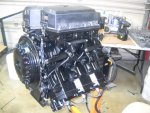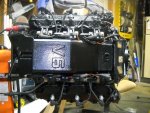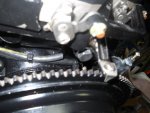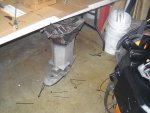Re: Update 02-20-2011
Re: Update 02-20-2011
Like I said I cut off all the electrical tape last night from the harness, it was coming off anyways and needed to be fixed. I did not notice any bumps like a molded in fuse link. I can tell you where the tan wires all come together, about 3" above trim relay box, they are all soldered, crimped, and shrinked wraped together. I just cut the extra wires there about 3/4" from this "connection" and then marine heat shrinked them, sqeezing them to make seal when hot. So what ever diode is there is still there. My concern with this diode was if it was in one of the connectors where the shift interupt switch and the power pack are. Just wanted to make sure that there was not some kind of order that these connection here and that bull crap. Because all three connectors could go to any one of each other on these tan wires up under there.
Well I finished off the electrical last night other than mounting my new starter. It hadn't come in until this morning. So it gets mouted tonight. Here is how the electrical came out. Everything nice and cleaned up. I'm sticking with the factory plug. Not going with the terminal block. I'll just patch the harness from the boat to the harness from the engine in the boat after hatch. That'll be fun!:facepalm:



Also to finish out my questions on the additional idle rework curcuit that Faztbullet directed me to do. Here is how the end of the hose at the top of the block and how it terminated. Is this correct? Will this discharge oil spray like a disconnected PVC valve on a car engine? Should I make up a foam breathable cover of the end. It will help with reducing the oil mist issue. Just do not want a fire in the stator. Here is the pic of how it terminates now with out foam cover.

Tonight I am taking off work and getting out of the garage. lol This weekend I move on to the mid section. Here is how it sits. All prepped and ready for paint.

I figure that I will paint everything in the midsection and transom plates. I love my gas mask!

Then give them a couple of days to dry properly before assembling things. Al the while I am rebuilding/resealing the trim unit. Still waiting on my special wrench from Austraila to come in so I can remove the cylinder caps. It was way cheaper than buying it in North Amercia even with shipping.
Also need to severly clean up the garage again. Wow are the zip tie pieces all over the floor are starting to get thick!
My only worry about this whole rebuild is my top two carbs. When I was torquing down the four car bolts on the top two carbs. The factory service manual stated that the bolts should be torqued to a very high torque for a plastic carb in my opintion. It sort of warped them a bit when I was torquing, so I stopped well before I fully torqued them. I might remove them and check them for air leaks in the bowls. It appears it might of warped the flat plan the bowls seal on. Anyone else have this problem with the book on this one torque. I just tightened the rest by hand and feel. But I might need to buy a couple of carbs to replace them if there is a leak. Damn! Don't know yet.
If anyone can anything else I might have problems with please let me know.






























